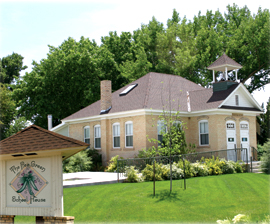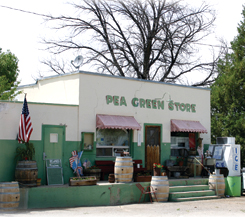Outlook still rosy in old Pea Green
“The town’s current residents can trace their roots back to it’s earliest beginnings.”
Story by Caitlin Switzer Photography by Kathryn R Burke
All content © San Juan Publishing Group, Inc. All rights reserved.

[SW Colorado] Rumor has it that this sleepy little town west of Olathe was once called something else, but from the time the earliest schoolhouse —built around 1888, when settlers arrived on the heels of the departing Ute Indians —received a bright coat of pea green paint, nobody remembers what that first name was. It is a place where crops grow tall, and roses pile in lush abundance beside old farmhouses. It is a place called Pea Green, named after the original paint on the old schoolhouse.
The town has an interesting history. “The way Pea Green got started was that it was on the road to the tiny crossroads community of Transfer,” explained local historian Marilyn Cox, whose mother attended school at Pea Green. According to Cox, lumber that was needed to build homes and shops in the newborn (and nearby) town of Delta was hauled by bobsled from the Plateau to a transfer point, where it was graded and stacked and then brought by team to the valley.
Pea Greene is six miles south of Delta on State Highway 348. The area had long been known to travelers, noted Pea Green historian Caleb Casebier in an article published in the Montrose Daily Press in 1991. “…today, driving along…through a landscape of farm homes, you would never believe that a little over one hundred years ago this was a wilderness of cactus and vast entanglements of thorny brush that the Indians called ‘Chico,’” Casebier wrote, “yet offering to both man and beast the one commodity so essential to life itself—water.” A spring flowing to a tributary called Buttermilk Gulch once hosted a winter camp for large numbers of Indians. “Interestingly, this water also served a worn cross-country trail traversing north and south,” Casebier wrote. “In the course of time, the ‘Indian Trail’ was dropped in favor of the commonly known Coal Bank wagon road.”
Lumber mill owner Herman Darling moved his operation here in the 1880s. “There was plenty of water there to run his mill and to support a boardinghouse,” according to Cox. “He hired a man named Jim Roatcap to hand develop wells along the road to Transfer in order to provide water for the teamsters and their animals. The first well was in what is now the Pea Green area, so that became a center of activity.” A blacksmith soon arrived to set up shop in Pea Green, and more families followed.
“When a little school house was built and painted a pea green, the community was dubbed the same and remains so today,” Cox said. That first schoolhouse was quickly outgrown, and was replaced several times over the years, before the small country schools were consolidated and abandoned in the 1950s. (The old school house was most recently used as a private residence.)
Today, Pea Green is still largely agricultural, The collection of bright green buildings that remains includes the old schoolhouse, a store and the community center—a hub of local activity that did not have indoor plumbing, a modern furnace or an electric cook stove until it was renovated in 1997.

“The community center is right across from the school,” Cox said. “It was used all the time, and still is. When we were growing up, it was off limits to us—they had dances, and people brought liquor, so it was pretty rough—there were brawls and fights.” Today, the building is listed on the National Register of Historic Places, and no alcohol is allowed, Cox said.
Although time has brought many changes to Pea Green, a number of the town’s current residents can trace their roots back to its earliest beginnings. Helen Burch has lived in Pea Green for sixty years. “The community has changed,” she said. “It is not so close knit—but it used to be that everybody helped each other, and everybody worked with each other.” Ralph Ray was born in Pea Green seventy-six years ago, after his father and grandfather moved over from Lazear in 1906. “We had lunches at the community hall when I was going to school,” he recalled. “We had eight grades at the Pea Green School, and I went on to Olathe High and graduated.” Ray made his living as a rancher, growing feed in the summer, and feeding it to cattle brought down from Gunnison during the long, cold winters. “Was it a good life?” he pondered. “I guess so, because I am still right here.”
Ralph Ray was born in Pea Green seventy-six years ago, after his father and grandfather moved over from Lazear in 1906. “We had lunches at the community hall when I was going to school,” he recalled. “We had eight grades at the Pea Green School, and I went on to Olathe High and graduated.” Ray made his living as a rancher, growing feed in the summer, and feeding it to cattle brought down from Gunnison during the long, cold winters. “Was it a good life?” he pondered. “I guess so, because I am still right here.”
Helen Burch would agree. “This is home,” she said.
Photography by Kathryn R. Burke
Pea Green School
Pea Green Store
Ed Note: Pea Green was established in the late 1800s, when the Utes left the area. When we “Googled” Pea Green, we didn’t find much; the area is old and sparsley settled now – but the cemetery records provide a wealth of information.
